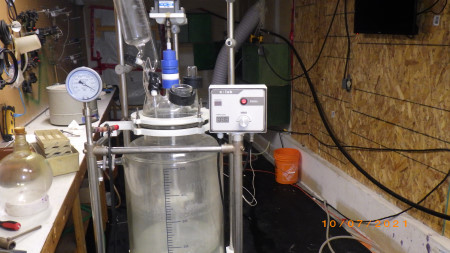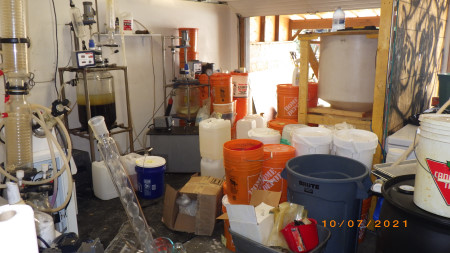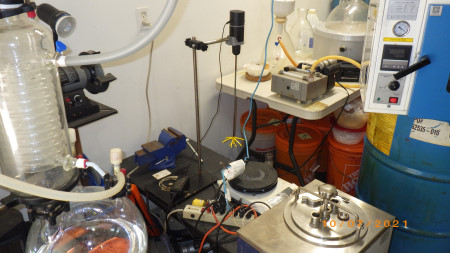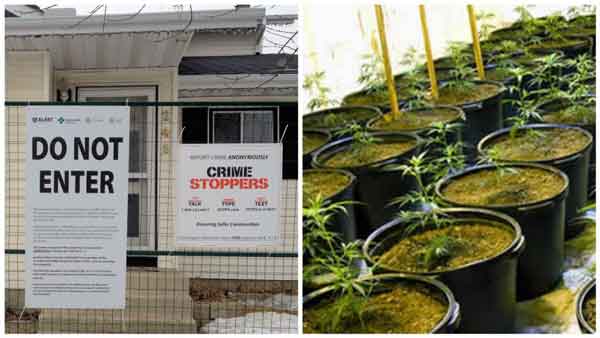Removing toxic chemicals and chemical waste in a safe and efficient manner is complicated.
Fentanyl drug labs are being discovered at an alarming rate across the country. During Fentanyl Busts, the chemicals being used are often unlabelled, which makes cleaning much more dangerous and difficult.
For everyone’s short and long-term health and safety, hazardous materials must be handled and disposed of properly.
With years of experience in drug lab remediation in Calgary and surrounding areas, we have become a trusted partner for lab clean-up after a fentanyl bust.
In this post, we’ll cover common illicit substances, when drug lab remediation is required and the dangers of exposure.
Meth, Fentanyl & Other Illicit Drugs
Years ago, methamphetamine (meth) was the main concern for first responders and police services when dealing with overdoses and drug labs.
Meth was the drug of choice since it’s highly addictive, low-cost, and easy to produce. Meth labs were discovered everywhere, from residential and non-residential buildings to vehicles and rural acreages.
The chemicals involved in the production of methamphetamine are highly explosive with fumes that are very harmful. These factors make the cleanup process a highly dangerous job.

Now, the rise in popularity of synthetic opioids, like fentanyl, has made things even worse. Drugs being smuggled into the country are likely coming in bulk form. Whether they come in a pill format, it is common for drug dealers to turn the product into powder, allowing them to cut the fentanyl with other substances.
Other illicit drugs include carfentanil, amphetamines, heroin/opioids, cocaine, MDMA/Ecstasy. As police and health authorities continue their work in this field, this list of substances continues to grow.
When is Drug Lab Remediation Required?
Drug lab remediation is the term used to describe the professional removal of substances, such as illicit drugs from a site. According to Alberta Health Services (AHS), properties that have been exposed to illicit drugs, even if it’s a potential exposure, should hire a professional remediation company that specializes in hazardous material remediation.
Within their Fentanyl Remediation Guide, AHS provides a Fentanyl Remediation Flowchart that should be used to evaluate a potential drug lab site and determine the level of exposure and necessary steps for remediation. The purpose of this guide is to keep all involved in the Fentanyl Bust, from discovery to remediation, safe from fentanyl exposure.
 The process begins with an off-site assessment conducted by professionals who were notified by law enforcement. This includes gathering background information, preparing a health and safety plan, and preparing a sampling plan.
The process begins with an off-site assessment conducted by professionals who were notified by law enforcement. This includes gathering background information, preparing a health and safety plan, and preparing a sampling plan.
Next, an on-site evaluation is conducted to determine the extent of the contamination. This includes a visual assessment and samples are taken and tested from surfaces around the site. If the level of contamination cannot be determined, appropriate PPE should be worn and protective control measures should be taken.
During the drug lab remediation process, a general approach taken for safety includes:
- Work area isolation
- Personnel protection
- Fentanyl decontamination procedures
- Personnel and equipment clean-up and decontamination
- Equipment and personnel decontamination
- Proper waste handling and disposal
Professional remediation specialists are experienced and equipped to handle drug lab clean-up in a safe and effective way.
The Dangers of Fentanyl Exposure
Even if there is no drug lab and no drug processing, but just illegal drugs being used by a single user, there is still a risk of contamination in the area.
Porous material such as upholstered furniture, curtains, bedding, or clothes can hold residue long after the drugs have been used. This is why these items should be properly disposed of. Even heating, ventilation and air conditioning (HVAC) systems can be compromised. If powder or residue enters the ventilation system in a home, it can spread through the air.
Since such tiny amounts of fentanyl can be deadly, any location where fentanyl has been used should be treated with as much caution and cleaned using the same process as a full drug lab site.
Wear personal protective equipment when appropriate, especially in situations where there may be a high exposure risk of airborne fentanyl powder. Short-term effects of fentanyl include:

- Dizziness
- Confusion
- Drowsiness
- Slow breathing
- Nausea or vomiting
- Itching or hot sensation on the skin
Within just 2 minutes of exposure, life-threatening effects can occur.
Work With Mayken™ for a Safe Drug Lab Remediation in Calgary
Mayken™ Hazmat Solutions is a trusted industry leader for dealing with drug lab remediation after a fentanyl bust. We have successfully remediated numerous fentanyl labs, including the largest lab in Canadian history.
We take extra care and precautions to ensure a former drug lab site has been returned to a clean and safe state. Our team continues to work with Alberta Health Services to ensure local government regulations are followed and improved when necessary.
If you’re looking for a professional remediation company to work with for drug lab remediation in Calgary and surrounding areas, get in touch with our team today.






















